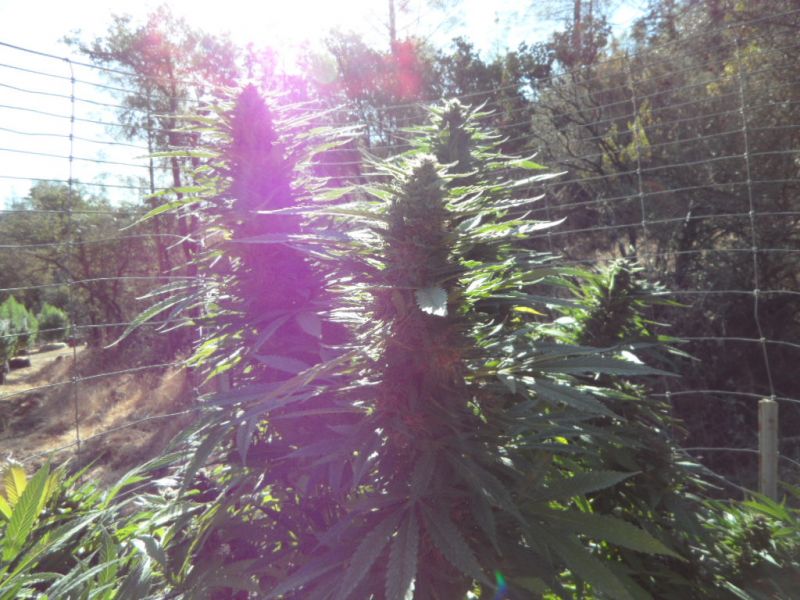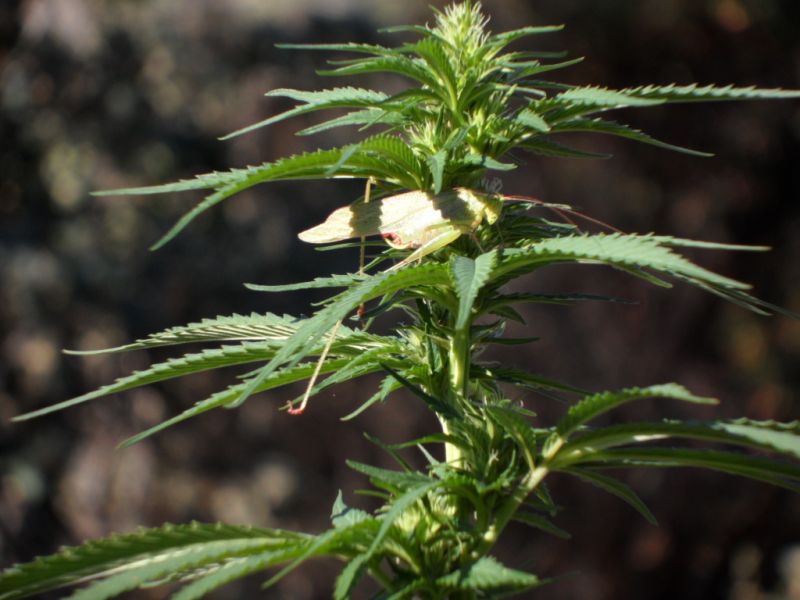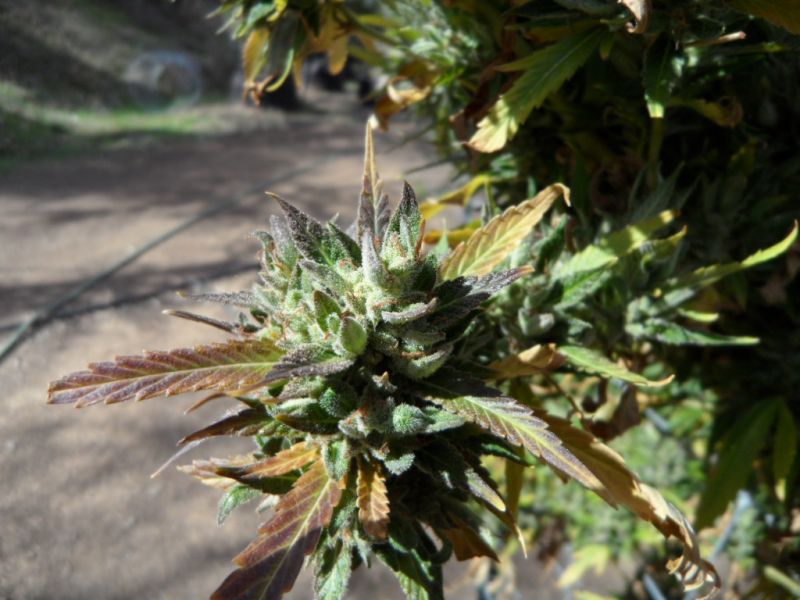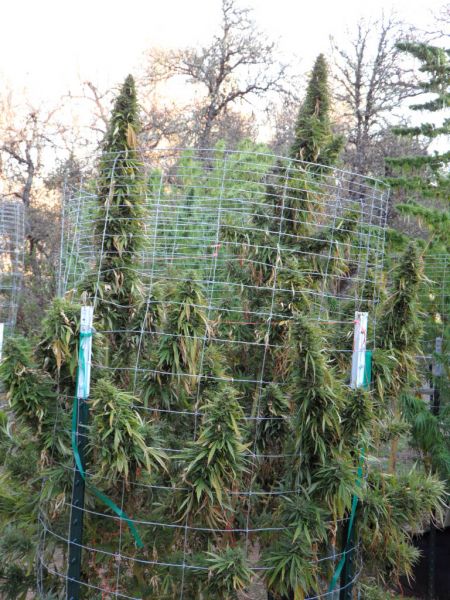 A market glut and paranoia about criminal cartels getting into the act coincide with the end of the CAMP program. Can Northern California's cannabis industry remake itself along ecological and community-rooted lines?
A market glut and paranoia about criminal cartels getting into the act coincide with the end of the CAMP program. Can Northern California's cannabis industry remake itself along ecological and community-rooted lines?
With the 2012 fall harvest season, Northern California's legendary cannabis-growing Emerald Triangle—centered around the counties of Humboldt, Mendocino and Trinity—is at a turning point. And as the old cliché goes, the Chinese character for crisis is made up of the characters for danger and opportunity.
The current juncture is ripe with both.
For 28 years, the now-defunct Campaign Against Marijuana Planting (CAMP) sent helicopter-mounted teams of state, federal and local officers into the region’s remote forests to hunt down and destroy cannabis grows. But this year, with California crippled by shortfalls, Gov. Jerry Brown cut CAMP from the state budget. The program has been restructured under direct federal leadership—and a new moniker, the Cannabis Eradication and Reclamation Team (CERT). The Drug Enforcement Administration (DEA) and other federal agencies are now working directly with local law enforcement, with no involvement from the effectively disbanded state Bureau of Narcotic Enforcement.
The program has been somewhat downsized. Fewer teams were dispatched in 2012, and the amount of cannabis ripped from illegal back-country grow sites has plummeted for the second year in a row. As harvest season drew to a close, the statewide figure for eradicated plants (both by CERT and a joint DEA-Forest Service program called Operation Mountain Sweep) was 1.5 million, mostly from federal forestlands—less than half of last year's figure. That’s down from a decade high of about 7.3 million plants in 2009. This year's seizures look be the lowest since 2004—reflecting depressed prices, the day-lighting of the industry by the state medical marijuana program, and a shift to indoor and private-land cultivation.
"Due to 215, fear of law enforcement has diminished, so the need to clearly violate federal law by planting in the National Forests has also diminished," Humboldt Sheriff Mike Downey told Skunk, referring to the historic 1996 ballot initiative that instated California's medical marijuana law, Proposition 215. He also says there has been a decrease in growing on private timber company holdings in the county.
Eradication efforts in the county are overseen by the sheriff’s Drug Enforcement Unit, with one deputy in the unit cross-deputized to the DEA under the CERT program.
Use of the word "reclamation" in the new program’s title is intended to convey an ecological aspect to CERT’s work—playing on new concerns about the environmental impacts of the cannabis industry. Tommy Lanier, chief of the White House-funded National Marijuana Initiative, told Humboldt County's Eureka Times-Standard: "That's a big priority for us—to get the infrastructure out of these parks, to reduce the impacts and reclaim our watersheds."
Similar rhetoric was wielded by Randy Wagner, the DEA special agent in charge of Northern California operations. At the start of the CERT campaign, he told the Times-Standard: "It's one of the most beautiful parts of this country, but it's just being destroyed by marijuana cultivation. I can tell you, we're going to be hot and heavy in Humboldt County from here on out."
 Can the cannabis economy go green?
Can the cannabis economy go green?
The feds are exploiting the ecological concern, not creating it. The Emerald Triangle was raped by the timber barons in 1990s, when their breakneck liquidation of the old-growth redwoods sparked protest and direct-action campaigns by radical environmentalists, who blocked the bulldozers and occupied the treetops. The cannabis industry in the Triangle was pioneered by back-to-the-land hippies who looked to the herb as a green alternative to the timber economy. But as cannabis has taken over as the economic mainstay, its has started to take its own ecological toll.
"I'm skeptical about propaganda, but the environmental threats are real," Humboldt County District Attorney Paul Gallegos told Skunk. "Paper-cuts is the analogy—one isn't going to kill you, but a whole bunch and you’ll bleed to death. Diversions of creeks and pumping water out of rivers up to the grows is actually reducing rivers flows. Every human activity has an adverse impact on the environment, and this is an unregulated industry because the feds have created a situation where its impossible to regulate."
And this persists despite 215. "California has legalized a certain amount of this activity, but it is still unregulated even for people who are in compliance with state law," Gallegos says. "And the growers don’t want any regulation because it would mean a database for an activity still illegal under federal law, and that’s a legitimate concern for them."
Earlier this year, a five-county study assessing impacts on salmonids named unpermitted grading as a major factor—and cited the cannabis industry as a key culprit. The Five Counties Salmonid Conservation Program was launched in 1997, to coordinate watershed protection among Humboldt, Mendocino, Trinity, Del Norte and Siskiyou counties, at a time when the big culprits were corporate loggers. Few anticipated then that cannabis growers leveling private lands with bulldozers would be a key factor in river siltation, and a threat to salmon. But when the study was presented in Eureka, the county seat, Humboldt Supervisor Mark Lovelace said in reference to photos he’d viewed of grow-related grading: "It's shocking. It compares with the worst of the worst from some of the bad years of the timber industry."
And there are more gruesome issues. A recent study by UC Davis biologists found that potent rat poisons used on large-scale cannabis grows on forest lands throughout California may be killing off larger mammals—and infecting the entire food chain. The study documented the deaths of fishers—a ferret-like critter that is a candidate for protection under the Endangered Species Act. Almost 80% of fishers found dead by researchers between 2006 and 2011 had been exposed to high levels of anticoagulant rodenticide—rat poison, in the vernacular. And all the deaths of exposed fishers occurred between mid-April and mid-May—just when cannabis growers are using large amounts of poison to protect their seedlings. Some of the rodenticides are treated with “flavorizers” to make them taste like bacon, cheese or peanut butter—so fishers could be eating the poison directly. More likely, the fishers are exposed through eating rodents. And since fishers have the same prey as such threatened or endangered species as condors, spotted owls and martens, this dilemma has implications for the whole forest ecosystem.
Alison Sterling Nichols, a co-founder and former executive director of the Emerald Growers Association, speaks forthrightly: "The problem is real. Any industry when completely unregulated develops out of control, greed can trump the environment. There are massive illegal water diversions, grading with bulldozers on private lands. Nutrient loads wash into creeks, leading to algal blooms on the Eel River. Authorities have warned not to let dogs swim in the Eel River. We have to be a responsible industry."
Nichols also cites the use of pesticides on indoor cannabis that were developed for ornamental plants—and not approved or intended for human consumption. "And some of this is for medical marijuana, that will be smoked by cancer patients," she marvels. "That's the last thing they need."
It did nothing to endear Humboldt County's Native Americans to local growers when more than 26,000 cannabis plants were discovered in August on Hoopa Valley tribal land. The Hoopa Tribal Police worked with the Sheriff's office, US Marshals and the Bureau of Indian Affairs to uproot the stuff. The Hoopa Valley Tribe, already hit hard by the region's methamphetamine plague, expressed outrage that large-scale growers had trespassed on their lands. Tribal chairman Leonard Masten said the operation posed a potential environmental threat from fertilizers and pesticides that could run off into nearby Mill Creek, a source of salmon for the tribe. "We're very conscious of what we do on our land, and it’s our responsibility to protect it so that, 100 years from now, new generations coming up still have it," Masten told the Times-Standard.
Nichols believes most growers are well-intentioned. "If people are rooted in our community and care about the watersheds, they'll do the right thing," she says. And indeed, some growers are rising to the occasion in addressing this issue. Idealistic hippie collectives are marketing their bud as organic, and there is a growing push by eco-conscious cannabis connoisseurs to "Grow it in the Sun!"—a repudiation of the hydroponic craze. "We could have organic sun-grown famous Humboldt County cannabis without the pesticides or the carbon footprint," Nichols enthuses.
But here too, federal prohibition is an obstacle. "Organic is a trademark owned by the feds, so you're not supposed to apply it to pot," says Nichols. "There are no cultivation guidelines because it’s an unregulated industry, because it’s illegal."
"Shutting down big dispensaries in Oakland just fuels the black market," Nichols laments, referring to the federal threats against Harborside Health Center, the state's largest. "But it's cheaper to pin a note to a door in Oakland than clean up rat poison on the public lands. It's a complete mis-allocation of resources."
And while the crunchy hippies represent one current in the industry, there is another growing tendency that fully embraces the ethic of cut-throat capitalism, or worse...
Cartels moving in?
Last year, the Emerald Triangle was officially designated a "High Intensity Drug Trafficking Area" by the federal government, joining the southwest and northwest borders. In unprecedented raids in Mendocino National Forest last year, 10 Mexican nationals were among the approximately 100 arrested. And authorities say that armed confrontations during marijuana raids are growing—cited as further evidence that Mexico's murderous cartels are getting in on the local cannabis action, squeezing out the hippies and mountain men. The media have had a field day with the claims, including a special on PBS "News Hour" at the opening of last year’s harvest season.
Says Sheriff Downey: "I think we've been seeing Mexican cartels and other money laundering organizations for years. They're definitely directing a lot of production of marijuana in California, according to intelligence we’ve received from people we’ve arrested."
But Lt. Wayne Hanson, to whom Skunk was referred by Downey for details on this intelligence, had few specifics. He did cite the sheer scale of some recent grow ops—a record 133,000 plants were found at one site in 2007 (compared to an average 20 to 30 thousand). That same year, a Mexican national was killed by deputies in a confrontation at a raided grow site. Since then, he could only cite "multiple people of Hispanic descent" arrested at grow sites, and "Hispanic foods" left behind.
Says DA Gallegos: "I think its real, but I don’t think its pervasive. It certainly excites pre-existing prejudices, if you will. They're certainly out there, there's no getting around it that some of them are very dangerous criminals. If you think about it—if there’s immense value added and no regulation, someone is gonna step in with their own regulation and try to drive everyone else out. The profit margin is so large that it challenges everyone’s commitment to lawfulness. We bust houses that our own officers could never afford. So the people who are law-abiding say 'Hey I’m in the wrong business.'"
Fear is also growing in Humboldt over a wave of busts and home break-ins. In once incident in Salmon Creek this year, four men with ski-masks and shotguns forced entry to a local couple's home, tied them up, and made off with 30 pounds of cannabis and more than $3,000. Held for about an hour as the assailants searched the premises, the couple only managed to free themselves and call the police after the assailants fled.
In a move that raised eyebrows among local residents, the accused head of a cannabis cultivation operation near Bridgeville—Taco Nikolov Budnakov, a naturalized US citizen from Bulgaria—was sentenced to serve 1,000 hours of community service and forfeit almost $40,000 in cash under the terms of a plea agreement in January. But Budnakov’s four trimmers—three Bulgarians and a Ukrainian—spent almost two months in jail before they were allowed to plead "no contest" to misdemeanor charges of being an accessory to a crime, receiving time served (54 days). Five others—from Bulgaria, Ukraine, Germany and Thailand—received similar deals deals. Budnakov himself was released on $75,000 bail, and only served two days. The incident came amid growing concerns about Russian mafias in the Humboldt cannabis biz, with potential links to human trafficking.
However much truth there may be to fears of a local cartel presence, the government has been predictably quick to play the "narco-terrorist" card. Just after the 2010 harvest, federal, state and local officials in a Northern California counter-terrorism drill played out a scenario in which local cannabis growers went on a bombing spree and took over the Shasta Dam, the nation's second largest, to free an imprisoned comrade. A local news report said that in the mock-terror scenario, a cannabis growers' "red cell" set off bus and car bombs as distractions, took over the dam with three hostages, and then "threatened to flood the Sacramento River by rolling open the drum gates atop the dam."
 Day-lighting the industry
Day-lighting the industry
The federal crackdown on California’s medical marijuana dispensaries has hit the Emerald Triangle hard. Cultivators who sought legitimacy through the medical market are now seeing that market shrink as dispensaries are shuttered. So they are fleeing to the black market, leading to a glut—which is now ironically hurting the remnant medicinal market. With cheap weed getting dumped in Humboldt’s college town of Arcata, local dispensaries say business is down 75%. The price of top-line bud has dropped from around $5,000 to under $1,000. "Last I heard, a pound of marijuana is $800 for outdoor grown," gloated Mendocino County Sheriff Tom Allman to the Sacramento Bee. "That's plummeting. You might do better with tomatoes."
There are now only three dispensaries operating in Humboldt County, with a moratorium on new ones instated late in 2011. There were eight in the county a year ago. Five received threatening letters from feds—two in Eureka, two Arcata and one in Loleta.
And this year new, more restrictive regulations for private medical grows were instated, allowing 50 square feet of indoor canopy, and 1,200 watts of light used to cultivate with. Under the original 2004 ordinance, it was 100 square feet, and this limit applied individually to different people growing in same residence—so they could each have their own plot. Now the new, lower limit is per residence, not per individual.
"It effectively wiped out all collective growing," says Kevin Jodrey, cultivation director at the Humboldt Patient Resource Center in Arcata, one of the surviving dispensaries.
And regs for outdoor medical grows were supposed to have been released in May; they still haven't been, leaving outdoor growers in legal limbo.
"It's like a speeding ticket—we’re not gonna put a sign on the highway with a number, but the officer will pull you over and it'll change from day to day,"protests Jodrey. "How would you know you were in violation?"
DA Gallegos insists: "The attitude of law enforcement is not animosity towards the mom-and-pop personal use cultivation. But there are people who come in and plan to make a half a million in one season, and use backhoes and diesel generators and pesticides, because all they’re interested in is profit, like any corporation. They bring in workers who are in a completely vulnerable situation because it’s illegal—their cell phones are confiscated. That's who we’re going after."
Jodrey counters: "Mom-and-pop is never defined. The majority who are busted are small growers."
Jodrey is also skeptical about the ecological arguments. "Growers are being scapegoated for the environmental destruction of the region 20 or 30 years ago at the hands of the timber industry. The growers are just working with what's left. Sure, its a legitimate concern, you want to make sure the growers aren’t degrading the environment. Some growers are lacking integrity in the way they run their ops, but I don't think that’s the majority. But if you can showcase some malignancy, you can portray growers as ecological monsters."
Gallegos agrees that federal intransigence is driving the problem. "Every business up here, car dealerships, law firms—they all know were all invested in criminal activity," he states. "We'd like to say, 'Come out of the hills, we want to look at your books, inspect your work environment and your product, see what chemicals you’re using, let your workers unionize if they want to.' We should protect the workers, environment and community, like we do with every other industry. But we can’t because of the federal government, and that’s frustrating to me."
Gallegos makes the case for lifting the pressure in at least one limited sphere: "If the federal government would just let us regulate what’s legal in California, that would be nice. I understand that California marijuana gets around the whole country, so it isn’t just a state issue. But I believe that human beings have the capacity to sit down at the table and work out a rational solution."
And meanwhile, he says, "Good people who really need it are in fear, and the people who are in it for the money and don’t care about the community are acting with impunity."
 Hippies, rednecks, Indians and the feds...
Hippies, rednecks, Indians and the feds...
The Emerald Triangle has a clear west-east cultural divide between the hippie coast and the redneck interior. In inland Trinity County, Sheriff Bruce Haney has joined with his counterparts from neighboring counties to form a "Constitutional Sheriffs" group, in an implicit challenge to federal control over the region’s rugged and resource-rich public lands. At a May meeting in Trinity, Haney hosted the sheriffs of Mendocino, Del Norte, Siskiyou, Tehama and Modoc counties. The meet took place at a "Defend Rural America" conference in the old Gold Rush outpost of Weaverville.
Issues discussed included National Forest Service management plans, possible expansion of spotted owl habitat, and the planned removal of dams on the Klamath River. The increasing presence in the forests of Mexican and Russian cannabis grow ops linked to criminal mafias was also a top concern.
Opposition to removal of the Klamath River dams—owned by Warren Buffet's PacifiCorp—will pit the "Constitutional Sheriffs" against local enviros. It will also meet opposition in the Hoopa Indians, who see restoration of the Klamath's salmon as key to their cultural survival and recovery.
Control of the forests is also at issue for Indians as well as the Sheriffs' constituency. The Winnemem Wintu, with a reservation at Tuiimyali outside Redding, in May held a "War Dance" of civil disobedience, blocking off a 400-yard stretch of their sacred lands along the McCloud River in the Shasta National Forest, to protest the Forest Service's refusal to enforce closures of these areas during traditional ceremonies. At one coming-of-age ceremony held at the site, teenage Wintu girls were heckled and abused by boating tourists. The Wintu also oppose the federal Bureau of Reclamation's plans to raise the Shasta Dam, which would flood their sacred lands.
For over a century, there have been split-the-state plans in California, although little consensus on where to draw the line. Most proposals have called for a North-South division, with the border placed anywhere from San Francisco to Santa Barbara. But there is also an East-West division, with the border following the crest of the Coast Range—right through the middle of the Emerald Triangle. With more rednecks turning to cultivation as the timber industry goes bust, cannabis culture increasingly pervades both of the "two" Californias up here at the north end of the state. The one thing that could unite the hippies, rednecks and Indians alike is opposition to federal overreach in the war on cannabis...
This story first appeared in the October issue of Skunk magazine.
Photos of Trinity County Blueberry and Matanuska strains by Purple Kush







Recent comments
1 week 4 days ago
5 weeks 3 days ago
9 weeks 3 days ago
10 weeks 1 day ago
20 weeks 1 day ago
24 weeks 2 days ago
25 weeks 2 days ago
25 weeks 2 days ago
46 weeks 3 days ago
50 weeks 4 days ago